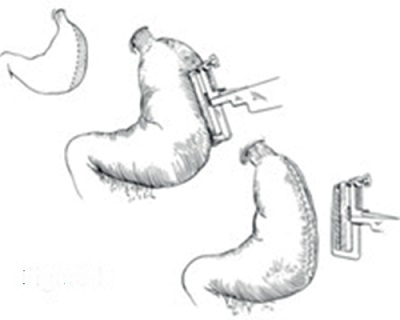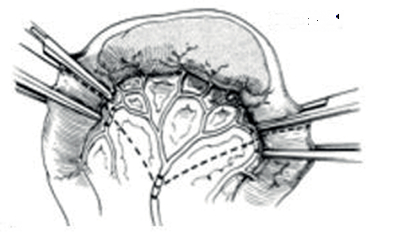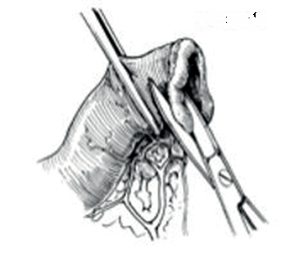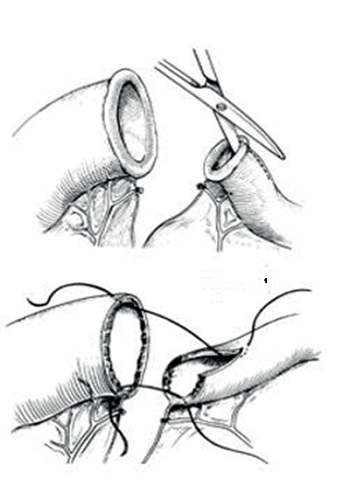Gastrointestinal surgery is performed very commonly in small animals for biopsy, removal of a foreign body, upper gastrointestinal bleeding, resection of a nonviable segment of intestine, resection of nonviable portion of the stomach, and resection of a neoplasia. Gastrotomy, gastrectomy, enterotomy, and enterectomy are the procedures routinely performed. General principles common to all of these procedures have to be followed.
Peritonitis is a life-threatening complication that can happen in 13 to 20% of the cases. To reduce the risk of peritonitis, it is important to minimize the trauma to the tissue and to recognize the tissue viability. Peritonitis can develop in the immediate postoperative period because of severe contamination during the surgery or leakage of the suture line. Leakage happens if the tissues are not viable or when the surgical technique was not appropriate. Peritonitis can happen also 3 to 4 days after surgery at the peak of debridement. Dehiscence of an anastomosis happened because the debridement phase goes beyond the suture line. If the tissue handling or the surgical technique were not appropriate, the debridement will be exacerbated and dehiscence can occur.
Antibiotic Prophylaxis
Gastrointestinal surgery without a peritonitis is considered as a clean-contaminated surgery. Therefore, antibiotics are required during the procedures. Most common bacteria encountered during gastrointestinal surgery are: Escherichia coli, Enterococcus spp., Streptococcus, Staphylococcus aureus, Proteus, and Bacteroides fragilis. In the stomach, the bacteria population is more limited than in the rest of the intestine because of the acidic environment. In the colon, the population of anaerobic bacteria is elevated.
Before surgery, the patient is placed on prophylactic intravenous antibiotic. For the surgery of the stomach, ampicillin or first-generation cephalosporin (20 mg/kg IV every 60 min) can be used. For the rest of the intestine, second-generation antibiotics are preferable, because they have a broad spectrum against gram + and -. Cefoxitin (20 mg/kg IV every 90 min) is the antibiotic of choice. A combination of ampicillin enrofloxacin can be used also especially if a peritonitis is present. Antibiotics are interrupted at the end of the procedure unless the animal has peritonitis. The animals need to be watched closely for signs of infection.
Choice of Suture Material and Needles
A wide range of suture materials has been used during gastrointestinal surgery. It is recommended to use synthetic absorbable monofilament suture materials. Synthetic absorbable sutures are absorbed primarily by hydrolysis, which is very predictable. Monofilament sutures are less traumatic than braided sutures when they are placed through the wall of the gastrointestinal tract. However, they have more memory which makes them harder to work with. A monofilament suture size 4.0 or 3.0 is recommended for gastrointestinal surgery. A small suture material will more likely trigger less inflammation. Glycomer 631 (Biosyn) or Monocryl is a very good choice since it retains 50% of its tensile strength for 3 weeks. A taper needle is recommended for placement sutures in the stomach wall and the intestine, because it does not cut the fibers of collagen.
Suture Pattern
The gastrointestinal tract is closed with a simple continuous suture pattern to provide apposition of all the layers of the wall of the gastrointestinal tract. It is important to place the suture full thickness to make sure the submucosa is incorporated. This suture technique will provide primary healing of the wall of the gastrointestinal tract. When a simple continuous pattern is used, it is recommended to place the first and the last stitches with knots outside the incision because it may provide a very good seal. When the sutures are placed, it is important to avoid traumatizing the wall of the gastrointestinal tract. It is then better not to grab the wall of the gastrointestinal tract with grasping forceps as much as possible. When the sutures are placed, it is important to follow the curvature of the needle to reduce trauma to the soft tissue.
Asepsis
Every effort should be made to prevent contamination of the abdominal cavity during gastrointestinal surgery. The stomach or the loop of intestine is "packed off" the rest of the abdominal cavity. Layers of moist laparotomy sponges are used. Intestinal content is moved away for the surgical site with gentle manipulation, and atraumatic clamps are placed to prevent the intestinal content from coming back. Stay sutures are placed in the stomach to elevate the stomach wall and prevent spillage of stomach content into the peritoneal cavity.
After completion of the surgery, the peritoneal cavity is lavaged with warm sterile saline solution to remove gastrointestinal spillage and blood clots. Usually 1 liter of saline is used for a 10-kg dog. The entire fluid is eliminated with surgical suction to get the peritoneal cavity as dry as possible.
Gloves and instruments are then changed. New surgical towels are placed on the edges of the laparotomy. The abdominal cavity is then closed routinely.
Assessment of Viability
Stomach
No objective criteria exist to evaluate the gastric wall viability. Absence of peristaltic wave, pale greenish to gray serosal color, thin gastric wall, and lack of bleeding after partial-thickness incision are signs of gastric wall devitalisation.
Intestine
Viability is assessed by coloration of the serosa, peristalsis, pulse in the jejunal arteries, and utilization of intravenous fluorescein. Fluorescein at the dose of 15 mg/kg is injected intravenously. Fluorescein emits a gold-green fluorescence when exposed to ultraviolet light. Viable intestine has a smooth uniform green-gold fluorescence. Hyperemic intestine has a brighter color than normal. Nonviable intestine has patchy fluorescence or no fluorescence. The fluorescence can also be located around blood vessels.
Surgery of the Stomach
Gastrotomy
Gastrotomy incision is performed in a relatively avascular area, midway between the lesser and the greater curvature of the stomach. One stay suture is placed at each end of the planed gastrotomy incision. Stay sutures are used to manipulate the stomach and bring the stomach wall to the edge of the abdominal incision. The stomach is walled off with moist laparotomy sponges to prevent contamination of the abdominal cavity with gastric content. An 11 blade is used to stab the gastric wall next to one stay suture. Then, a Metzenbaum scissors is used to extend the gastrotomy incision. The incision should be long enough to remove the foreign body without tearing the stomach wall. Hemorrhage occurs mainly in the seromuscular layer and can be controlled by ligation with fine absorbable sutures. The foreign body is extracted and the gastrotomy closed. Gastrotomy is closed with one-layer simple apposition pattern with 3-0 monofilament absorbable suture. The abdominal cavity is lavaged with warm saline prior to closure. Surgical gloves are changed, and a new pack of instruments is then used to complete the abdominal closure.
Gastrectomy
Gastrectomy is required to resect the nonviable part of the stomach wall during GDV, or resection of an ulcer or a neoplasia. Stomach wall resection for a gastric ulcer requires wide margin since gastric ulceration could be associated with gastric adenocarcinoma or gastric lymphoma.
Two options are available: gastrectomy with either traditional suture technique or stapling suture. Gastrectomy with automatic stapling equipment is associated with the best post-surgical outcome during GDV. This is the recommended technique.
Gastrectomy During GDV
Branches of the short gastric arteries and left gastro-epiploic artery supplying the area to be resected are ligated. Nonviable gastric wall is resected with Metzenbaum scissors to the level of healthy gastric tissue. Closure with suture material is possible. This technique is associated with 60% mortality. If autostapling equipment is available, a thoracoabdominal device (TA 55 or 90) can be used to perform the gastrectomy (Figure 1). The TA 55 or 90 placed two staggered rows of staples respectively 55 or 90 mm long. The length of staples for stomach wall resection should be 4.8 mm. The TA 55 or 90 is first clamped on healthy stomach wall. The two rows of staples are then fired, and a 15 blade is used to resect the devitalized stomach wall. The TA is then released. The suture line is then inspected to be sure that all the staples are in correct position, and then a simple inverting suture line is applied. The advantages of this technique include decreased surgical time and decreased abdominal contamination from gastric spillage. Mortality rate with the autostapling equipment is close to 10%. Stomach rupture at the time of surgery is associated with severe peritonitis.
| Figure 1 | 
|
|
| |
Gastrectomy for Ulcer or Mass
After identification of the stomach ulcer or tumor, the healthy stomach is retracted with stay sutures to prevent gastric spillage. The stomach wall is then resected around the lesion. The stomach wall is highly vascular. Bleeding blood vessels on the line of incision are ligated with 4.0 monofilament absorbable sutures. Staples can be used to close the gastrectomy. Hand suture can be performed if stapling equipment is not available. Two inverting continuous sutures have been used to close the stomach after gastrectomy. A Cushing suture followed by a Lembert is the traditional technique. However, one simple continuous apposition suture can be used to close the stomach.
Surgery of the Intestine
Enterotomy
A variety of foreign bodies can be ingested by young animals. Linear foreign bodies are more common in cats. Once an object has passed through the pylorus, the next smallest lumen are the distal duodenum and the proximal jejunum. Plication of the intestine indicates the presence of a linear foreign body. Usually one end of the linear body is still located in the stomach and needs to be released first. Particular attention is paid to mesenteric border, especially with a linear foreign material. Linear foreign body can cut through the mesenteric border and induce leakage of intestinal content. Multiple enterotomies may be required to remove the entire linear foreign body. Enterectomy is required if the mesenteric border has been damaged. Enterotomy is performed immediately distal to the foreign material. Intestine is walled off the abdominal cavity to prevent leakage of intestinal content inside the abdominal cavity. The incision on the antimesenteric border should be long enough to extract the foreign body without tearing the intestine. The enterotomy is then closed with a simple interrupted appositional pattern with 4-0 monofilament absorbable suture. Since the submucosa is the only holding layer, it needs to be incorporated in the suture. The submucosa tends to retract away from the edge of the incision. The everted mucosa can be trimmed away to allow better exposure of the submucosa. A serosal patch can be performed to improve blood supply to the enterotomy site and increase its tensile strength. The abdominal cavity is lavaged with warm saline prior to closure. Surgical gloves are changed, and a new pack of instruments is then used to complete the abdominal closure.
Enterectomy
An enterectomy is indicated if the intestine is not viable (intussusception, volvulus), perforated by a linear foreign material at the mesenteric border, or if an intestinal neoplasia is present. End-to-end anastomosis is the preferred technique to perform an enterectomy. Intestine is walled off the abdominal cavity to prevent leakage of intestinal content inside the abdominal cavity. Enterectomy requires double ligation of the branches of the arteriovenous supply of the portion of intestine to resect (Figure 2).
| Figure 2 | 
|
|
| |
The terminal arcade is also double ligated. Transection is performed between the double ligations. Crushing clamps are then placed on the portion of intestine that is going to be resected. The clamps are either placed perpendicular or at a slight angle toward the normal intestine. Non-crushing clamps are placed on the normal intestine 4 to 5 cm away from the enterectomy site after milking away the intestinal content. The intestine is transected with a scalpel blade using the crushing clamps as guide. Since the submucosa is the only holding layer, it needs to be incorporated in the suture. The submucosa tends to retract away from the edge of the incision. The everted mucosa can be trimmed away to allow better exposure of the submucosa (Figure 3).
| Figure 3 | 
|
|
| |
Anastomosis is performed with simple interrupted or continuous appositional pattern with 4-0 monofilament absorbable suture (Figure 4).
| Figure 4 | 
|
|
| |
If the two extremities of the intestine are not of equivalent diameter, the smaller diameter segment can is incised on the antimesenteric border to create a larger spatulated edge (Figure 4). A serosal patch can be placed around the enterectomy site to improve blood supply and tensile strength. The abdominal cavity is lavaged with warm saline prior to closure. Surgical gloves are changed, and a new pack of instruments is then used to complete the abdominal closure.
Postoperative Monitoring
Postoperatively the patients should be monitored for signs of peritonitis, hypotension, disseminated intravascular coagulation, and pain. Patients can be fed 8 hours after surgery unless the patient is vomiting. Feeding tubes might be required to support those patients. Peritonitis occurs in 13 to 20% of the cases. Leakage after gastrointestinal surgery can happen within 24 hours of surgery because of nonviable tissue or inappropriate surgical technique. It can also happen 3 to 4 days after surgery at the peak of the debridement phase. Clinical signs of peritonitis will be tachycardia, tachypnea, acute abdominal pain, hypoglycemia, and hyperthermia. An abdominocentesis is then required to confirm the presence of bacteria in the abdomen. If bacteria are presented past 8 hours after surgery, the anastomosis is leaking and a second surgery is required.